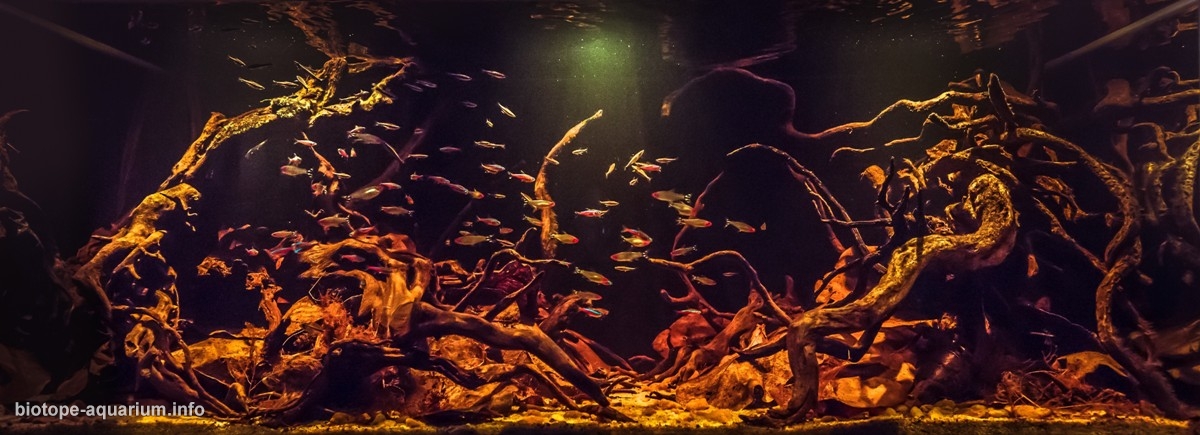Igarapé Cajari, a tributary of Rio Caurés, Amazonas, Brazil
39th place in Biotope Aquarium Design Contest 2019
India. Achintya Shankar Adhikari

Volume: 270 L
Dimensions: 120x45x45 cm
List of fishes: Hemigrammus Bleheri, Paracheirodon Axelrodi, Apistogramma Mendezi, Nannostomus Eques, Nannostomus beckfordi, Corydoras Adolfoi
List of plants: N/A
Description of decorations: The roots and branches I have used are branch woods. I have used 2 types of woods, couple of them are thicker branch woods & couple of them are thinner woods. These woods I used in my previous setups & those are with me for around 7-8 years. So, these are well seasoned. The leaves I have used are Indian almond leaves which is abundant here. There are some broken leaves which makes a messy layer over ground level as we can generally see in this region. The substrate is a mixture of JBL river sand & yellow sand. There are some branches which are fallen from top, as we can see in the amazon rainforest. Also, to replicate ‘tea colour’ water in this Igarape Cajari area, Indian almond leaves do the job of making tea coloured ‘blackwater’. Apart from that, during water change I use Natural Humin which is a product of ‘Discusfood’ company.
Description of equipment: External filter Fluval 306, Eheim 2217, LED spotlight 5W*3 4500K
Water parameters: Temperature is 27°C, ph is 4.8, kh is 2
Additional info: Interesting part of this aquarium is, in this tank Corydoras adolfoi lays eggs couple of times. But I have a hard luck to successful hatch. Also, in my aquarium I have paired Nannostomus Eques. I have this aquarium for more than 1.5 years & most of the fishes are from the beginning. Igarape Cajari which is a tributary of Rio Caurés doesn’t have fast flowing water. So, to replicate that water flow I deliberately keep low flow of water in my aquarium.
INFORMATION ABOUT BIOTOPE
Description of the area surrounding the biotope: Rio Negro is the second largest river in South America with many river tributaries that eventually end up with smaller forest streams. One of these forest streams is Igarapé Cajari, which is a tributary of Rio Caurésю
Description of the underwater landscape of the biotope: In Amazonia, during the rainy season with a heavy rainfall water level rises and eventually it’s flooded into the surrounding forest area. In this time, fish migrates into the submerged forest where abundant food sources are found, and the breeding begins. We know, any forests represent as a major source of plankton and other natural foods. With the water level rises, this turns into a necessary area for young fish, as well as for adult ones. With the amount of fallen leaves, which acts as a source of infusoria, is ideal of baby fishes. Other than providing natural food for fish, forests provide them with the shelter from predators and create the shadow above water, thereby preventing overheating and even excessive drying during the dry season. The soil is sandy and with almost no mineral content. A large amount of leaf litter forms a dense carpet, along with the roots of the flooded forest and branches. Water carries a large amount of detritus. Detritus contains decomposing organic matter, including animal remains, plant residues, waste products, and bacteria and other microorganisms associated with them.
Description of the parameters of the habitat: During the rainy season (starts September 6 and lasts for 8.7 months, ending around May 29) the water is considerably colder and temperature is about 23 °C, water pH is about 6ph. During the dry season (starts around May 29 and lasts for 3.2 months, ending around September 6), the water level is reduced and warmer, the temperature of water is around 28-30 °C. Due to the low water level and the large amount of leaves and branches, the water contains a large concentration of tannins, which adds a dark color like “Tea color” and the water pH is low and is about 3.5-4ph.
List of fishes and invertebrates occurring in the nature biotope: Paracheirodon Axelrodi, Iguanodectes adujai, Hemigrammus bellottii, Hyphessobrycon paepkei, Hyphessobrycon jackrobertsi, Apistogramma Mendezi, Nannostomus Eques, Nannostomus trifaciatus , Nannostomus beckfordi, Nannostomus digrammus, Carnegiella strigata , Hemigrammus Bleheri, Dicrossus filamentosus, Crenicichla notophthalmus, Mesonauta festivus, Fluviphylax zonatus. Coroydors adolfoi.
List of plants found in the nature biotope: At the location of the biotope, I have mentioned there are no water plants, except the forest flooded plants.
Threats to the ecology: Now a days there are 2 threats of natural habitat of this Amazon rainforest biotope: 1. Deforestation of Amazonia 2. The logging of the Amazon rainforest “Lungs of the World” i.e. Amazon rainforest is already gone more than 20 % and much more is severely threatened as the destruction continues. If the trees and plants are destroyed, that means the area around where the rainforest sits – a region that depends on water from the Amazon for up to 70 percent of its economic activity – is likely to dry out. It is estimated that the Amazon alone is vanishing at a rate of 20,000 square miles a year. Vivid beauty that comes with great diversity in plants and animals, rainforests also play a practical role in keeping our planet healthy. By absorbing carbon dioxide and releasing the oxygen that we depend on for our survival. The absorption of this CO2 also helps to stabilize the Earth’s climate. We can already see a huge number of Cardinal tetra are being exported across world. In recent report, their numbers are massively decreasing. Same thing applies for other fishes like discus, Altum angel etc. So it’s high time “To know Mother Nature, is to love her smallest creations”.
Sources of information:
https://en.climate-data.org/
https://www.seriouslyfish.com/
http://www.tfhmagazine.com/
